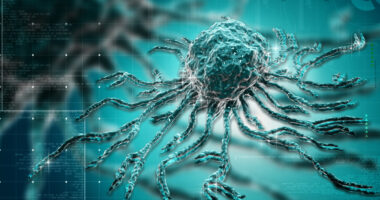Two genes identified as potential drivers of PAH with HIV infection
Hub genes ISG15 and IFI27 may serve as biomarkers, say researchers

Two genes were identified as potential drivers of pulmonary arterial hypertension (PAH) in people with HIV-1 infection in a bioinformatics study, offering new perspectives to uncover the underlying molecular mechanisms that link HIV infection and PAH.
The genes ISG15 and IFI27 are established hub genes involved in the type I interferon (IFN) response pathway, particularly in monocytes, an immune cell that’s crucial for fighting off infections. Hub genes have many interactions with other genes and usually play key roles in biological processes.
“ISG15 and IFI27 demonstrated promising diagnostic potential in the PAH dataset, and they may serve as potential biomarkers for PAH,” the researchers wrote in “Identification of the shared hub gene signatures and molecular mechanisms between HIV-1 and pulmonary arterial hypertension,” which was published in Scientific Reports.
PAH occurs due to a narrowing of the pulmonary arteries, the blood vessels that supply the lungs. The resulting high blood pressure leads to shortness of breath and forces the heart to work harder to pump blood to the lungs.
What causes the pulmonary arteries to narrow isn’t clear, but it’s thought to involve abnormally rapid growth, inflammation, and scarring of the tissues around the blood vessels.
Infection with HIV-1, the most common virus that causes acquired immunodeficiency syndrome, or AIDS, is considered a major cause of PAH by triggering the dysregulation of inflammatory and immune responses. People with HIV-1-related PAH have a lower survival rate than infected patients without PAH.
“However, the [origin] and [disease mechanisms] of PAH remain incompletely elucidated, particularly in cases associated with HIV-1,” said the researchers, who conducted bioinformatic analyses using gene expression profiles from the Gene Expression Omnibus (GEO) database to identify hub genes and molecular mechanisms shared by HIV-1 and PAH patients.
Possible mechanism of PAH with HIV shown
Three datasets for HIV, including 89 patients and 23 healthy people, and three for PAH, of 101 patients and 57 healthy people, were incorporated in the analysis. A software tool called Weighted Correlation Network Analysis (WGCNA) helped identify 109 genes shared by HIV and PAH patients, mainly involved in the type I IFN pathway and antiviral immune response. The type I IFN pathway is an immune signaling cascade that’s triggered when cells detect viruses.
A total of 61 genes were differentially expressed between HIV-1 patients and the healthy people, who served as controls, 40 of which were at higher levels, or upregulated, in patients and 21 at lower levels, or downregulated. Similarly, PAH patients had 519 differentially expressed genes compared with the health controls — 389 upregulated and 130 downregulated.
By taking the intersection of important module genes and differentially expressed genes, ISG15 and IFI27 were identified as pivotal hub genes, which are a subset of genes within a biological network that are highly connected, have a significant influence on the network’s function, and are often involved in essential biological processes.
Researchers also conducted an analysis based on gene expression to calculate the relative abundance of several types of immune cells, called immune infiltration analysis. Gene expression is the process by which information in a gene is synthesized to create a working product, like a protein. The analysis indicated a positive correlation between ISG15 and IFI27 expression and monocytes in both HIV-1 and PAH patients.
“It could therefore be inferred that the upregulation of ISG15 and IFI27 promotes monocyte activation and differentiation … by IFN stimulation,” the researchers wrote. “In summary, our study illustrated the possible mechanism of PAH secondary to HIV-1 and showed that the heightened IFN response in HIV-1 might be a crucial susceptibility factor for PAH, with monocytes being pivotal cells involved in the type I IFN response pathway.”








